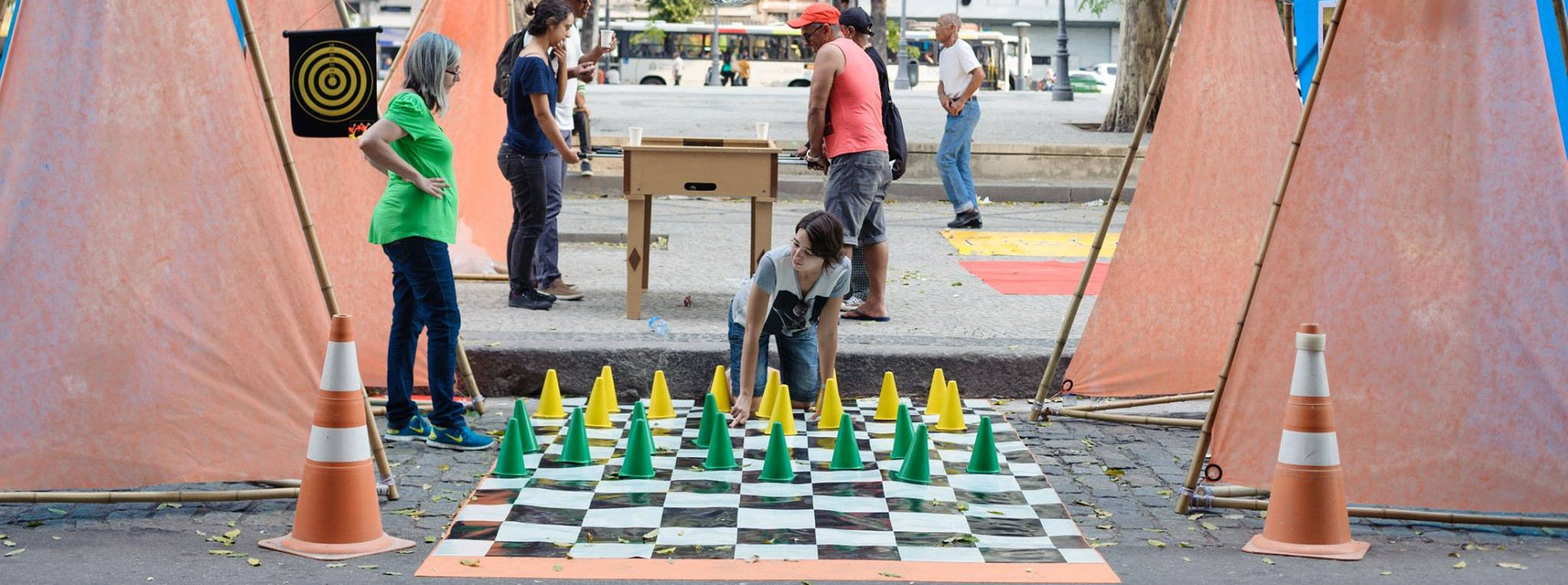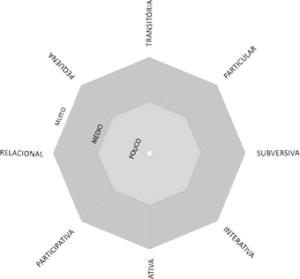
Temporary Interventions in Rio de Janeiro
This website offers a mapping of the temporary interventions in the city of Rio de Janeiro, allowing any person to research, stay informed and indicate new interventions that are happening or which have been completed in the city. This mapping is being undertaken by the Temporary Interventions Laboratory (LabIT), which is dedicated to the study of these actions as a type of positive transformation in the city of Rio de Janeiro.
Our goal is to strengthen the relationship between temporary interventions and the city’s collective spaces, creating a cartographic record of the temporary sites that allows us to better understand how our spaces are appropriated. To achieve this, we worked to identify, file, map and interpret these interventions based on the following types: spontaneous appropriations, public art interventions and local festivals. We believe that, by identifying those places where the city is transformed, prompted by the temporary transformation of public space, it becomes possible to rethink contemporary collective spaces and make these more lovable and significant to users.
Whenever possible, the images seen on our website were contributed by our team. Often times, however, due to the very nature of the intervention (temporary), the sources of the images originate from the websites of the projects, artists’ blogs or Facebook. We work to highlight the source of the information and images in the “For More Information” link. If you want to notify us of some missing reference or source, please send us an e-mail.
The Temporary Interventions Laboratory (LabIT) is an interdisciplinary initiative between Rio de Janeiro institutions involving three centers: PROURB-FAU/UFRJ (Graduate City Planning Program-School of Architecture and City Planning at the Federal University of Rio de Janeiro), EBA/UFRJ (School of Fine Arts at UFRJ) and the Design Course at the Pontifical Catholic University – PUC-Rio.
Besides the cartography of the temporary interventions, LabIT is working to complete concrete interventions that can activate forgotten or underused spaces in the city, contributing toward more lasting transformations. They are developed through workshops with undergraduate and graduate students from the institutions involved, joining the areas of architecture and city planning, visual arts and design.
The project emerged from the development of research on the book “Intervenções temporárias, marcas permanentes. Apropriações, arte e festa na cidade contemporânea” (“Temporary Interventions, Permanent Traces. Appropriations, Art and Festivals in the Contemporary City”), by Adriana Sansão Fontes, published by Casa da Palavra in 2013.
Temporary Intervention – formative characteristics
Temporary intervention, according to the research definition, is the intentional action of transformation of a space, which, to a greater or lesser degree, is characterized by the condition: transitory (in relation to duration), small, particular (in relation to place), subersive (in relation to some pattern of use/law), interactive (in relation to people), active (in relation to space), participatory (made from the bottom up) and relational (in stimulating socialization).
Navigation and Search Mechanisms
The website search system offers visitors different navigation options, both in the “map” and “list” views.
– To the right of the “Perform your Search” box, three icons represent the different types: “spontaneous appropriations, public art interventions and local festivals.” Your choice isolates the interventions corresponding to each category;
– Any term can be entered into the “Perform your Search” box, and the mechanism searches all content from the registered interventions;
– The search can be refined by categories related to the interventions, such as actors, duration, site and date, among other groupings, as described below;
– The bottom bar contains a timeline, which allows you to view the growth of interventions year by year;
Types and their characteristics
The mapped interventions were organized into types that immediately present some of their characteristics. On the other hand, it is possible to search and consult the database based on type of interest.
Spontaneous appropriations
– Motivation for occupation and activation of space
– Subversive aspect
– Dynamism, flexibility and vitality
– Building identity
Public Art Interventions
– Artistic motivation
– New ways of interacting with users
– New forms of dialogue with the public space
– Surprise – adding value to the urban space
Local Festivals
– Reason for celebration
– Taking back public space – resistance
– Versatility and reversibility of space
– Participation and interaction with users – social cohesion
Tactical Actions
– Motivation of physical transformation
– Space test for future interventions
– Use of low cost materials
– Agility in implementation
Search categories
Actors
Parties involved with the intervention: authors, proponents, organizers, supporters. Individual, collective or institutional. Listed by name in alphabetical order.
Spatialization
The way in which the intervention uses the territory: transitional, linear or in network form. The commonly observed appropriations are those that occupy the territory in a transitional way, making use of some public square or small leftover space, while public art interventions and festivals can occur in a transitional, linear or network manner.
Support
Nature of the collective space that receives the intervention, exposing the intervention-site relationship. It may be everything from an active traditional public space to a residual public space: public square, beach, newsstand, building, blank wall, means of transportation…
Frequency
Refers to the pace at which the intervention will disrupt the daily routine: annually, bi-annually, daily, weekly, no specific pattern…
Duration
Period during which the intervention was active: hours, days, weeks…
Shift
Morning, afternoon or night.
Site
Specific site of intervention.
Neighborhood
Neighborhood that is/was site to the intervention.
Date
Allows the user to search using more specific dates: interventions during a specific year or month; interventions during periods of major events…
Axonometric Diagrams
Each registered intervention has in its gallery an axonometric diagram illustrating the composition of its eight formative characteristics (small, transitory, particular, subversive, interactive, active, participatory, relational). In the diagram, each feature has three levels of intensity, which increase from the center to the edges, representing “little”, “medium” and “very” for each feature. Therefore, each intervention can be read through the summary image of such characteristics.
At each end of the geometric figure there is the formative characteristic of the intervention.
Small:
The term is directly related to the size of the intervention. The smaller the intervention, the more external the point on the diagram.
Transitory:
The term relates to the duration of the intervention. The more external the point, the more transitory the intervention, in other words, the less time it will last.
Particular:
The term relates to how particular the intervention is to the context. The more external the point, the more context-specific the intervention will be.
Subversive:
The term is related to the adequacy of the intervention to the site where it is performed. The more unusual the location in relation to what is proposed in the intervention, the more subversive it will be. The more subversive, the more external point on the diagram.
Interactive:
The term is related to the interactivity that an intervention has with the public. The more interactive an action is, the outermost the point on the diagram.
Active:
The term is related to the activation of space, resulting from carrying out an intervention. The more the intervention activates the space, removing it from a condition of passivity, the more external the point in the diagram will be.
Participatory:
The term is related to the participation of different levels of entities in the idealization and implementation of the intervention. The more actors engaged in the intervention, the more participatory it will be, the more external the point in the diagram.
Relational:
The term take into consideration how much the intervention brings people into relationship. The more relational the intervention, that is, the more it proposes the interaction between different people, the more external the point on the diagram will be.
Coordinator
- Adriana Sansão Associate Professor at the Faculty of Architecture and Urbanism and the Postgraduate Program in Urbanism at UFRJ, Architect and Urbanist, Master and PhD in Urbanism at PROURB-FAU / UFRJ, with Post Doctorate and Doctoral Internship at ETSAB / UPC, in Barcelona. Current Young Scientist of… lattes
Team
-
Rodrigo Rinaldi
Architect and Urbanist FAU/UFRJ
PhD in Urbanism PROURB-FAU/UFRJ. Professor at FAU/UFRJ
-
Gabriel Pedrotti
Architect and Urbanist FAU/UFSC
PhD student PROURB-FAU/UFRJ
Master in Landscape Architecture PROURB-FAU/UFRJ -
Maini de Oliveira
Architect and Urbanist FAU/UFMG
PhD student PROURB-FAU/UFRJ
Master in Landscape Architecture PROURB-FAU/UFRJ -
Sergi Arbusà
Artist UB-Barcelona
PhD student PROURB-FAU/UFRJ
Master in Arts UFF -
Carolina Ferraz
Architect and Urbanist CEUB and UPC
PhD student PROURB-FAU/UFRJ
Master in Design UnB -
Aline Fernandes
Architect and Urbanist UFJF
Master in Urbanism PROURB-FAU/UFRJ
-
Gabrielle Rocha
Architect and Urbanist PUC-Rio
Master in Urbanism PROURB-FAU/UFRJ
-
Guto Santos
Architect and Urbanist FAU/UFRJ
Master in Landscape Architecture PROURB-FAU/UFRJ
-
Louise Brunet
Architect and Urbanist FAU/UFRJ
Master in Urban Planning and Design FEUP - Porto
-
Fernanda Schwarc
Architect and Urbanist EAU/UFF
Master student PROURB-FAU/UFRJ
-
Inês Domingues
Architect and Urbanist DAU/UFPE
Master student PROURB-FAU / UFRJ
-
Maia Lafer Naeh
Architect and Urbanist UNIFOR
Master student PROURB-FAU / UFRJ
-
Maria Pettersen
Architect and Urbanist IFF
Master student PROURB-FAU / UFRJ
-
Mariana Caetano
Student FAU/UFRJ
Scientific Initiation Scholarship UFRJ
-
Luiza Carolina
Student FAU/UFRJ
Scientific Initiation Scholarship UFRJ
-
Livia Borelli
Student FAU/UFRJ
Artistic and Cultural Initiation Scholarship UFRJ
-
Jefferson Teixeira
Student FAU/UFRJ
Volunteer
-
Giovanna Scalfone
Student FAU/UFRJ
Volunteer
-
João Pedro Pina
Student FAU/UFRJ
Volunteer
-
Larissa Martins
Student FAU/UFRJ
Volunteer
Collaborators
-
Joy Till
Architect and Urbanist Santa Úrsula
PhD in Urbanism PROURB-FAU/UFRJ
-
Aline Couri
Architect and Urbanist FAU/UFRJ
PhD in Urbanism PROURB-FAU/UFRJ
-
Fernando Espósito
Architect PUCV-Valparaíso, Chile
Doctor of Architecture ETSAB/UPC
-
Rodrigo Bertamé
Architect and Urbanist FAU/UFRJ
Master in Urbanism PROURB-FAU/UFRJ
-
Gabriela Bonifácio
Architect and Urbanist PUC-Rio
Master in Urbanism PROURB-FAU/UFRJ
Have been here
-
Carolina Souza
Student FAU/UFRJ
Scientific Initiation Scholarship CNPq/UFRJ
-
Mikhaila Copello
Student FAU/UFRJ
Scientific Initiation Scholarship CNPq/UFRJ
-
Barbara Lapos
Student FAU/UFRJ
Scientific Initiation Scholarship CNPq/UFRJ
-
Priscila Luzardo
Student FAU/UFRJ
Scientific Initiation Scholarship FAPERJ
-
Fernanda Pacheco
Student FAU/UFRJ
Artistic and Cultural Initiation Scholarship UFRJ
-
Cândida Zigoni
Student FAU/UFRJ
Scientific Initiation Scholarship CNPq/UFRJ
-
Victor Motta
Student FAU/UFRJ
Scientific Initiation Scholarship FAPERJ
-
Ana Clara Albuquerque
Student FAU/UFRJ
Artistic and Cultural Initiation Scholarship UFRJ
-
Ana Carolina Moreno
Student FAU/UFRJ
Artistic and Cultural Initiation Scholarship UFRJ
-
Larissa Neves
Student FAU/UFRJ
Volunteer PIBIC/UFRJ
-
Thaís Faria
Student FAU/UFRJ
Scientific Initiation Scholarship FAPERJ
-
Letícia Martins
Student FAU/UFRJ
Artistic and Cultural Initiation Scholarship UFRJ
-
Bianca Navega
Student FAU/UFRJ
Artistic and Cultural Initiation Scholarship UFRJ
-
Lara Liberatto
Student FAU/UFRJ
Artistic and Cultural Initiation Scholarship UFRJ
-
Dhoyene Assumpção
Student FAU/UFRJ
Artistic and Cultural Initiation Scholarship UFRJ
-
Carolina Tavares
Student FAU/UFRJ
Scientific Initiation Scholarship UFRJ
-
Brendha Leandro
Medicine Student
Volunteer
-
Bruno Lima
Student FAU/UFRJ
Volunteer
-
Djuanne Esmael
Student FAU/UFRJ
Artistic and Cultural Initiation Scholarship UFRJ
-
Desirèe Vacquez
Student FAU/UFRJ
Scientific Initiation Scholarship UFRJ
-
Ana Beatriz Kempf
Student FAU/UFRJ
Volunteer









